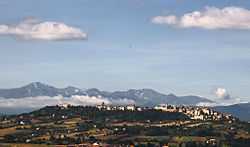Treia
| Treia | ||
|---|---|---|
| Comune | ||
| Comune di Treia | ||
 | ||
| ||
 Treia | ||
| Coordinates: 43°19′N 13°19′E / 43.317°N 13.317°ECoordinates: 43°19′N 13°19′E / 43.317°N 13.317°E | ||
| Country | Italy | |
| Region | Marche | |
| Province | Macerata (MC) | |
| Frazioni | Passo di Treia, Chiesanuova di Treia, Santa Maria in Selva, Camporota | |
| Area | ||
| • Total | 93 km2 (36 sq mi) | |
| Elevation | 342 m (1,122 ft) | |
| Population (31 December 2004) | ||
| • Total | 9,606 | |
| • Density | 100/km2 (270/sq mi) | |
| Demonym | Treiesi | |
| Time zone | CET (UTC+1) | |
| • Summer (DST) | CEST (UTC+2) | |
| Postal code | 62010 | |
| Dialing code | 0733 | |
| Patron saint | St. Patrick | |
| Saint day | March 17 | |
| Website | Official website | |
Treia is a town and comune in the province of Macerata in the central Marche (Italy). It is 7 km (4.3 mi) N of Pollenza, 12 km (7.5 mi) W of Macerata, and 18 km (11 mi) NNE of Tolentino.
History
Treia is said to have been founded by the Sabine people in 380 BCE; it is certain that at in the plain below the modern town and about 2 km (1.2 mi) to the west of it, at SS. Crocifisso, there was a small Roman town by that name, which is recorded as a municipium in 109 BCE. Large Egyptian religious statues of the Roman period have been found and are kept in the town's museum: they are unique in the Marche.
The Roman town appears to have been abandoned at the fall of the Western Empire, and only in the 10th century was a new town founded on the top of the hill, named Montecchio. The town sided with the Pope in the temporal struggles of central Italy, and was besieged several times, and in particular in 1239 by Enzio, son and vicar of Frederick II and again in 1263 by Conrad of Antioch, who was captured at the nearby battle of Vallesacco, and held for several months in town in a small prison (now in use as a caffé).
Montecchio eventually became part of the Papal States, and in 1790 Pope Pius VI rewarded it for its faithfulness by raising it to the official rank of "city", at the same time renaming it by its Roman name of Treia.
Treia's most famous native was the archaeologist and art critic Luigi Lanzi.
Main sights
- the medieval brick Duomo (cathedral)
- the 17th‑century Town Hall (Palazzo Municipale) includes a collection of Renaissance and classical paintings that may be visited on request
- Santuario del SS. Crocefisso, a large early 20th‑century church complex
- A museum of the town's history, inaugurated in 2004.
External links
(Text originally based on Bill Thayer's webpage, by permission.)
